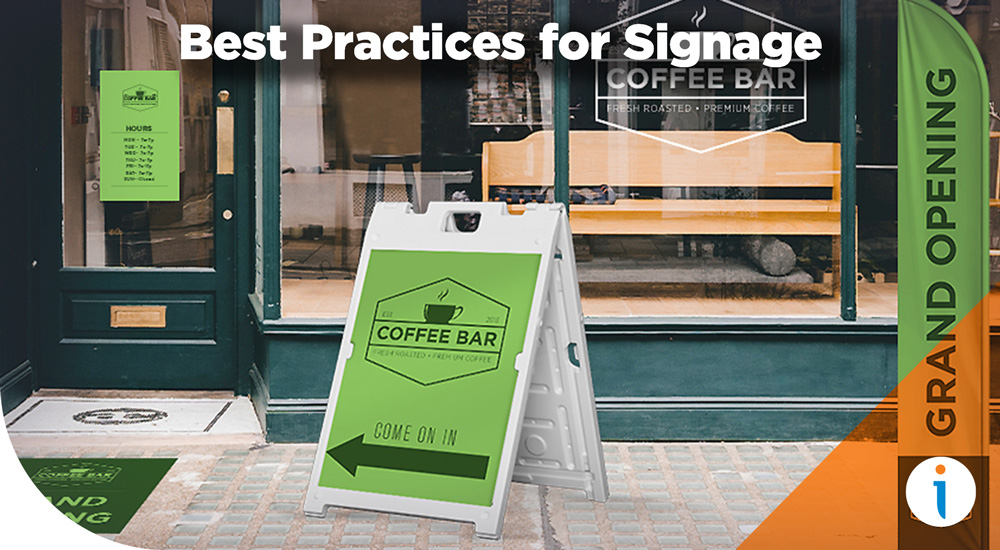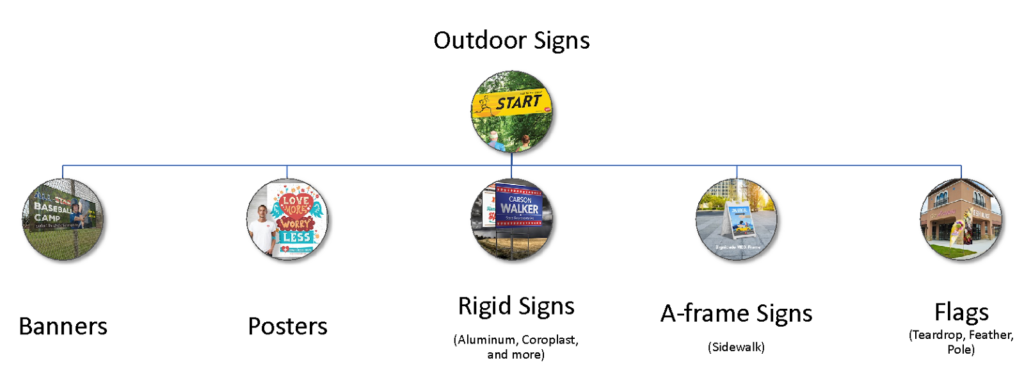Best Practices for Signage

Nowadays it takes a lot more than having your business name on the window or on the building to get noticed. When attracting people to your brick and mortar business signs help to grab their attention. According to the Sign Research Foundation, 60% of businesses that added or upgraded their signage enjoyed a 10% increase in sales. In fact, signs are ideal as they are designed to promote, engage, inform and sell. It’s not as easy as one would think to just pick a poster board, slap your logo at the top and voila…you’re done! No, it takes someone with knowledge in the print marketing business to help navigate the many choices in signage types, material choices, design options, and format sizes. That’s why we’re here to help! Check out our best practices when it comes to sign designs.
Location
When choosing a sign, first you need to determine where you want the sign to be, indoor or outdoor or both? We recommend using our decision tree for guidance. Indoor signs tend to be used for shorter periods like a special promotion and therefore do not need to be as durable. However, signs placed outdoors will need to withstand various weather conditions including sun exposure, varying temperatures, precipitation, and wind.


Best Design Choice
Placing the sign will have a weight on the design as it will depict the lighting that will have a great influence on the color, the viewing distance, and the context of the surrounding environment. Here are some options.
-
Window Graphics
A window graphic on a city bus is far different from a window graphic on a restaurant window. With a bus stop it requires more durable materials as well as a design that can be seen from a further distance. To help choose the best design, our team provides design specs, templates, and guidelines that work best for each type of sign.
-
Outdoor Banners
When it comes to outdoor banners there is generally a limited number of materials to choose from. For example, advertising in an outdoor space, a sign can be printed on scrim vinyl or mesh. The difference is that scrim vinyl is a solid, reinforced material that may also need wind slits added to allow the breeze to flow through the sign, whereas woven mesh materials inherently allow wind to flow through. Careful consideration is needed for how and where the sign will be mounted, attached, or otherwise installed. Banners can be hung with grommets, a sleeve, and a pole, or placed in a retractable stand. Road and yard signs that commonly use an aluminum frame that can be staked in the ground.
-
Floor Graphics
Floor graphics became very common during the Covid-19 pandemic to help guide people through aisles and where to stand. They are fixed on their location using affixed adhesives. Their environment will impact their placement as well as the installation.
-
Sidewalk Signs
Sidewalk signs allow smaller companies or shops within a walkable space to get noticed as they compete for attention and are a great way to attract people as they walk by.
-
Feather Flags
For non-retail businesses, feather flags are a great way to get noticed at events, trade shows, etc. It’s important to keep the design sharp, vibrant and easy to find.
Effective Design
Once these decisions have been made, the final design considerations come down to artwork and color choices. Research tells us that small unclear signs do not help a business. In fact, the Sign Research Foundation says that 61% of US consumers missed a business location because a sign was unclear or too small. Because the message needs to capture the viewer’s attention within seconds, bold colors with a simplified design is the best way to go. Photos, fonts and graphics must be sized appropriately.
If you’re ready to up your sign design game for your business then connect with our team of experts to learn more and get started today!


